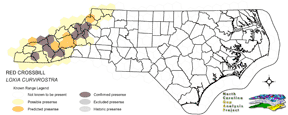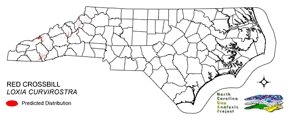
| Taxa: |
| Order: |
| Family: |
| Aves |
| Passeriformes |
| Fringillidae |
| NatureServe Global Rank: |
| NatureServe State (NC) Rank: |
| G5 |
| S3B,S3N |
| Federal Status: |
| NC State Status: |
| --- |
| W2,W3 |


| Land Unit |
| US Fish & Wildlife Service |
| US Forest Service |
| US National Park Service |
| US Department of Defense |
| NC State Parks |
| NC University System |
| NC Wildlife Res. Com. |
| NC Forest Service |
| NC Div. of Coastal Mgmt. |
| Local Governments |
| Non-Governmental Org. |
| Other Public Lands |
| Private Lands |
| GAP Status 1-2 |
| All Protected Lands |
| Statewide |
| Hectares |
| 0.00 |
| 11,175.21 |
| 0.00 |
| 14,225.13 |
| 464.76 |
| 3.51 |
| 79.38 |
| 5.64 |
| 0.00 |
| 416.70 |
| 1,029.96 |
| 1.08 |
| 18,974.07 |
| 17,124.81 |
| 27,398.04 |
| 46,375.44 |
| Acres |
| 0.00 |
| 27,614.54 |
| 0.00 |
| 35,151.05 |
| 1,148.45 |
| 8.67 |
| 196.15 |
| 30.69 |
| 0.00 |
| 1,029.69 |
| 2,545.09 |
| 2.67 |
| 46,885.94 |
| 42,333.07 |
| 67,718.77 |
| 114,612.94 |
| % of Dist. on |
| Prot. Lands |
| 0.0 % |
| 40.8 % |
| 0.0 % |
| 51.9 % |
| 1.7 % |
| < 0.1 % |
| 0.3 % |
| < 0.1 % |
| 0.0 % |
| 3.8 % |
| 3.8 % |
| 0.0 % |
| 0.0 % |
| 62.5 % |
| ----- |
| ----- |
| % of Dist. on |
| All Lands |
| 0.0 % |
| 24.1 % |
| 0.0 % |
| 30.7 % |
| 1.0 % |
| < 0.1 % |
| 0.2 % |
| < 0.1 % |
| 0.0 % |
| 0.9 % |
| 2.2 % |
| < 0.1 % |
| 40.9 % |
| 36.9 % |
| ----- |
| ----- |
|
Rare to uncommon in the mountains, usually preferring forests of conifers above 3,000 ft. (Hamel 1992, Simpson 1992). Potter et al (1980) lists the sightings of fledglings/immatures in the piedmont and coastal plain suggesting the possibility of widespread nesting outside of the mountains. Breeds primarily in coniferous forests (Adkisson 1996), although Ehrlich et al (1988) states crossbills will also breed in mixed forests. Kaufman (1996) lists the 'timing and distribution of nesting as quite irregular,' with breeding often occuring when 'cone crops are best.' Nest are hidden well in dense foliage on lateral branches, near or away from the trunk (Adkisson 1996). It is often constructed of conifer twigs, barks strips, grass, and rootlets, with fine grasses, lichens, needles, mosses, feathers, and hair lining the inner cup (Adkisson 1996, Kaufman 1996). Forages on the cones of conifers including, spruce, pine, fir, and hemlock (Adkisson 1996). Foraging occurs in the canopy of conifers, primarily near the cones, where the conifer seeds are retrieved and insects are gleaned (Hamel 1992). Crossbills will also eat buds of various trees, deciduous and weed seeds, and berries (Kaufman 1996). NATURE SERVE GLOBAL HABITAT COMMENTS: Coniferous and mixed coniferous-deciduous forests; also pine savanna and pine-oak habitat. In migration and winter occurs in deciduous forest, and more open scrubby areas. Nests in conifers, 1.5-25 m above ground, toward outer end of branch (Terres 1980). |
| Code | Name | Description | NC Natural Heritage Program Equivalent |
| 521 | Spruce/Fir Forest | High Elevation Frazer-Fir - Red Spruce, Red Spruce and Red-Spruce-Yellow Birch Forests. Tree densities included here include both woodland to forest density. Highly intermixed with Northern Hardwoods, Grassy Balds, and Shrub Balds. | Red Spruce--Fraser Fir Forest, Fraser Fir Forest |
| 527 | Appalachian Hemlock | Upland hemlock forests of the moutains region. Vary from side slopes to steep slope positions. | Canada Hemlock Forest |
| 528 | Appalachian Xeric Pine Forest | Pine forests and woodlands on xeric sites. A variety of pines, including Virginia, Shortleaf, Eastern White Pine, Table Mountain and Pitch pine. Often small areas of dense pine within a matrix of Xeric Oak-Pine Forests. | Pine Oak Heath |
|
Hamel, P. B. 1992. The land manager's guide to the birds of the south. The Nature Conservancy, Chapel Hill, North Carolina. 367 pp + several appendices.
Simpson MB Jr. 1992. Birds of the Blue Ridge Mountains. Chapel Hill and London: University of North Carolina Press. Adkisson, C. S. 1996. Red crossbill. In Poole A. and F. Gill., eds. The birds of North America. No. 256. Kaufman K. 1996. Lives of North American Birds. Boston, New York: Houghton Mifflin Company. Potter, E. F., J. F. Parnell, and R. P. Teulings. 1980. Birds of the Carolinas. Univ. North Carolina Press, Chapel Hill. 408 pp. Terres, J.K. 1980. The Audubon Society encyclopedia of North American birds. Alfred A. Knopf, New York. Ehrlich, P.R., D.S. Dobkin, and D. Wheye. 1988. The birder's handbook:a field guide to the natural history of North American birds. Simon and Shuster, Inc., New York. xxx + 785 pp. |
For more information please contact them at:
NC-GAP Analysis Project
Dept. of Zoology, NCSU
Campus Box 7617
Raleigh, NC 27695-7617
(919) 513-2853
www.basic.ncsu.edu/ncgap